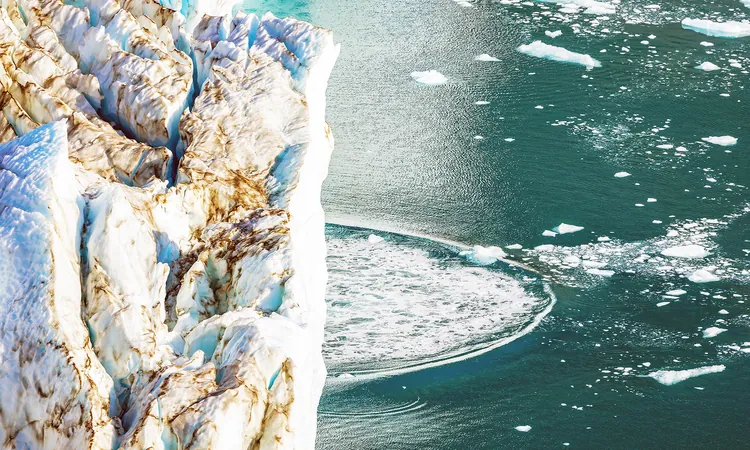
Unprecedented 650-Foot Tsunami in Greenland Captured by Satellite: Duration and Implications Revealed
2024-11-19
Author: Arjun
Scientists and oceanographers were left astounded by a remarkable phenomenon that unfolded recently in Greenland—a tsunami that reached an extraordinary height of 650 feet and lasted an astonishing nine days. Thanks to modern satellite technology, this rare occurrence has provided valuable insights into the behavior of tsunamis and their potential implications.
The Event: A Massive Rockslide and Its Aftermath
On September 16, 2023, a massive rockslide dumped over 880 million cubic feet of debris into the narrow confines of Dickson Fjord. This seismic event triggered a tsunami that reverberated through the fjord's steep walls, creating a series of waves that could not dissipate easily in the isolated body of water. Unlike the open ocean, where energy from such waves would diffuse quickly, the fjord served as a natural amplifier, allowing the waves to bounce back and forth every 90 seconds for a staggering nine days.
Breakthrough in Observation: The SWOT Satellite
The breakthrough in observing this phenomenon came from the International Surface Water and Ocean Topography (SWOT) satellite, which is a collaborative initiative between NASA's Jet Propulsion Laboratory and France's CNES (Centre National d’Études Spatiales). The satellite's advanced imaging technology offered a unique and detailed view of the tsunami's formation and behavior in real-time, allowing scientists to analyze the data and understand the dynamics at play.
Detailed Measurements and Insights
On the day following the rockslide, the SWOT satellite was precisely positioned to capture water elevation measurements within the fjord. The data visualization revealed a stark contrast in water levels; the northern side of the fjord showed elevations nearly 4 feet higher than the southern side, illustrated through a captivating color gradient in the satellite imagery.
Expert Insights and Implications
Josh Willis, a prominent sea level researcher at NASA, expressed excitement over the unprecedented opportunity to visualize the shape of the tsunami waves. "Seeing the shape of the wave—that’s something we could never do before SWOT," he remarked, highlighting the transformative nature of satellite technology in oceanographic research.
Understanding the Fjord's Impact on the Tsunami
The fjord's dimensions are impressive, stretching 1.7 miles wide and plunging to depths of 1,772 feet, with towering cliffs that rise over 6,000 feet above the water. This topography significantly influenced the behavior of the tsunami as the confined space hindered the usual energy dissipation, resulting in prolonged oscillations.
Broader Implications for Coastal Safety
Furthermore, this incident underscores the potential risk associated with tsunamis triggered by landslides, a phenomenon that is not as well-documented compared to those generated by seismic activity. The disturbances in this remote location raise questions about the safety protocols for coastal communities, particularly as climate change continues to impact geological stability.
Significance for Future Research and Disaster Preparedness
The September 2023 event marks a significant milestone in tsunami research and satellite technology's role in monitoring natural disasters. The insights derived from the SWOT satellite point to the necessity for enhanced predictive models to safeguard vulnerable communities around the globe.
The Role of Satellite Technology in Disaster Response
In addition to tsunami monitoring, satellites like SWOT are integral for tracking other natural disasters, including storm surges, flooding, and ongoing challenges related to sea-level rise. As we continue to utilize advanced satellite technologies, the knowledge gained will serve as a crucial tool in improving disaster preparedness and response strategies, ultimately contributing to more resilient communities worldwide.
Stay tuned for further updates as scientists delve deeper into the implications of this unique event and refine our understanding of nature’s powerful dynamics!


 Brasil (PT)
Brasil (PT)
 Canada (EN)
Canada (EN)
 Chile (ES)
Chile (ES)
 España (ES)
España (ES)
 France (FR)
France (FR)
 Hong Kong (EN)
Hong Kong (EN)
 Italia (IT)
Italia (IT)
 日本 (JA)
日本 (JA)
 Magyarország (HU)
Magyarország (HU)
 Norge (NO)
Norge (NO)
 Polska (PL)
Polska (PL)
 Schweiz (DE)
Schweiz (DE)
 Singapore (EN)
Singapore (EN)
 Sverige (SV)
Sverige (SV)
 Suomi (FI)
Suomi (FI)
 Türkiye (TR)
Türkiye (TR)